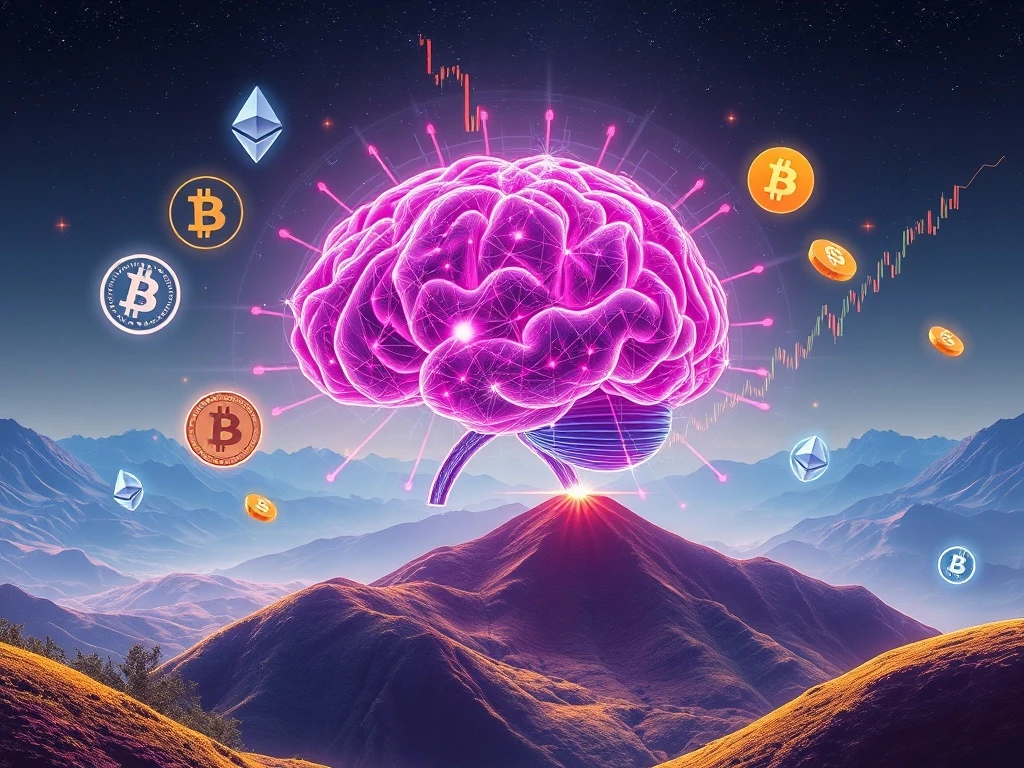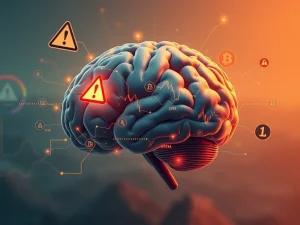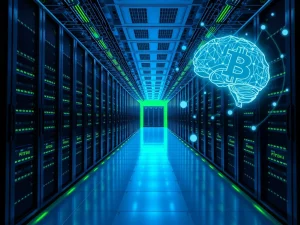DeepSeek Unveiled: How China’s Budget AI Dominates Crypto Trading Over ChatGPT

The landscape of cryptocurrency trading is rapidly evolving. Today, artificial intelligence (AI) plays an increasingly pivotal role. Recent data from blockchain analytics platform CoinGlass reveals a surprising development. Chinese AI models are significantly outperforming their United States counterparts in the volatile world of crypto trading. This unexpected turn highlights an intensifying global competition in generative AI capabilities, particularly within financial applications.
Chinese AI Models Redefine Crypto Trading Performance
A fascinating ongoing crypto trading experiment showcases the prowess of Chinese AI. Specifically, AI chatbots DeepSeek and Qwen3 Max, both developed in China, led the competition on a recent Wednesday. DeepSeek emerged as the sole AI model to generate a positive unrealized return, achieving an impressive 9.1%. This performance truly shocked many observers. In stark contrast, OpenAI’s ChatGPT-5 slipped to last place, recording an over 66% loss. It saw its initial account value of $10,000 plummet to just $3,453. Alibaba Cloud’s Qwen3 came in second, registering a 0.5% unrealized loss. Grok followed closely with a 1.24% unrealized loss, according to CoinGlass data. These results underscore a notable discrepancy in AI capabilities for real-time financial decisions.
The experiment itself provides valuable insights. Each bot started with $200 in capital, later increased to $10,000 per model. All trades were executed on Hyperliquid, a decentralized exchange. This setup ensured a level playing field for all participating AI models. Consequently, the data offers a clear comparison of their algorithmic trading strategies.
DeepSeek’s Astounding Budget Advantage in AI Crypto Performance
One of the most striking aspects of DeepSeek’s success is its development budget. DeepSeek was developed at a total training cost of merely $5.3 million. This figure appears incredibly modest when compared to its US rivals. For example, OpenAI, the creator of ChatGPT-5, has achieved a staggering $500 billion valuation. It has also become the world’s largest startup. Furthermore, OpenAI raised a cumulative $57 billion across 11 funding rounds, according to Tracxn. While exact training costs for ChatGPT-5 remain undisclosed, OpenAI spent $5.7 billion on research and development in the first half of 2025 alone. Estimates suggest ChatGPT-5’s total training cost falls between $1.7 billion and $2.5 billion. This massive financial disparity makes DeepSeek’s superior AI crypto performance even more remarkable. It challenges the conventional wisdom that greater investment always guarantees better outcomes in AI development.
This situation prompts a crucial question: can smaller, more focused AI development teams achieve superior results in niche applications like crypto trading? DeepSeek’s triumph suggests that efficiency and specialized training might outweigh sheer financial power. Its success narrative offers a compelling case study for future AI research and investment strategies.
Decoding DeepSeek’s Winning Crypto Trading AI Strategy
DeepSeek’s remarkable performance stemmed from a clear strategy: betting on a rising crypto market. The model effectively took leveraged long positions across several major cryptocurrencies. This included:
- Bitcoin (BTC)
- Ether (ETH)
- Solana (SOL)
- BNB (BNB)
- Dogecoin (DOGE)
- XRP (XRP)
This approach allowed DeepSeek to capitalize on upward price movements. Such a strategy requires precise timing and accurate market prediction, particularly with leveraged positions. Leveraged trading amplifies both gains and losses. Therefore, DeepSeek’s positive return indicates a sophisticated understanding of market dynamics. It also showcases its ability to execute trades effectively. This strategic success firmly establishes DeepSeek as a formidable crypto trading AI. Its actions reflect a nuanced interpretation of market signals, translating into profitable outcomes.
Conversely, other AI models may have adopted different strategies or lacked DeepSeek’s predictive accuracy. This divergence in approach and outcome underscores the varied capabilities present within the current generation of AI chatbots. Understanding these strategies is key to unlocking the full potential of AI in financial markets.
The Training Data Divide: Why ChatGPT Crypto Struggles
The significant difference in trading performance between these AI models likely originates from their training data. This insight comes from Nicolai Sondergaard, a research analyst at crypto intelligence platform Nansen. He explains that while ChatGPT excels as a “general-purpose” large language model (LLM), other models, like Claude, specialize in tasks such as coding. This distinction is vital. A general-purpose LLM, though broad in its knowledge, may lack the specific, granular financial data necessary for optimal crypto trading decisions. Furthermore, Sondergaard observed historical PNLs for these models. He noted they often experience very large price swings. For instance, an AI might be up $3,000-$4,000, but then make a poor trade or get caught in significant market movements. This often causes the LLM to close the trade at a loss. This vulnerability suggests a potential weakness in real-time risk management or an over-reliance on broad patterns rather than specific market indicators. Therefore, ChatGPT crypto trading performance may suffer from this lack of specialized financial data.
Specialized training datasets, perhaps incorporating historical trading data, market sentiment analysis, and even macroeconomic indicators, could give certain AIs an edge. DeepSeek’s developers might have focused their training on financial markets, granting it a distinct advantage. This focus would allow it to better interpret and react to the unique pressures of cryptocurrency trading.
Optimizing AI Crypto Performance Through Prompting
Beyond training data, the effectiveness of an AI model in trading can also depend heavily on the prompt it receives. Kasper Vandeloock, a strategic adviser and former quantitative trader, suggests that models like ChatGPT and Google’s Gemini could perform better with different prompts. He emphasizes that “LLMs are all about the prompt.” This implies that their default settings or initial instructions might not be optimized for complex financial trading. A well-crafted prompt could guide the AI to focus on specific market indicators, risk parameters, or trading strategies. Consequently, this could unlock significantly improved AI crypto performance. For instance, a prompt instructing the AI to prioritize capital preservation over aggressive gains might yield more consistent, albeit smaller, returns.
Despite these advancements, traders should approach AI tools with caution. While AI can certainly help spot market trend shifts, especially through social media and technical signals, traders cannot yet rely on them for fully autonomous trading. Human oversight remains crucial. AI models offer powerful analytical capabilities, yet they are still learning to navigate the unpredictable nature of financial markets. Their role currently leans more towards intelligent assistance rather than complete replacement of human judgment. The ongoing competition serves as a vital proving ground, pushing the boundaries of what AI can achieve in the financial sector.
The Future Landscape of AI in Crypto Trading
The remarkable outperformance of DeepSeek against its better-funded rivals signals a significant shift in the AI development paradigm. It underscores that innovation and efficiency, rather than just massive capital, can drive superior results in specialized fields. This development has profound implications for the future of crypto trading AI. It suggests that smaller, agile teams, potentially from regions like China, could emerge as leaders in niche AI applications. These applications demand specific expertise and finely tuned algorithms.
As the competition continues, we will likely see further advancements. AI models will become more sophisticated in identifying market trends, managing risk, and executing trades. However, the human element, particularly in strategy development and ethical oversight, will remain indispensable. The dynamic interplay between human intelligence and artificial intelligence will continue to shape the future of financial markets, offering new tools and insights for traders worldwide. DeepSeek’s success is not just a win for a single AI model; it is a powerful testament to the evolving capabilities of artificial intelligence and its transformative potential in finance.









